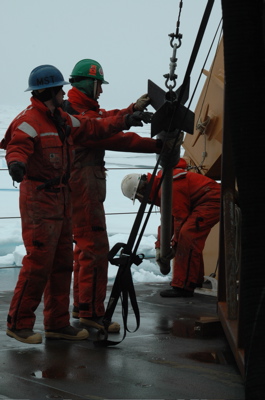( Log In ) Log In is for TREC Teachers & Researchers only
  |
| Steve_Stevenoski |
 Aug 8 2006, 12:55 AM Aug 8 2006, 12:55 AM
Post
#1
|
|
Member   Group: TREC Team Posts: 27 Joined: 19-July 06 Member No.: 39 |
August 5, 2006
Seal  I started the day by visiting the watch standers. We were in transit to a new coring site. Our arrival would be sometime this morning. Larry Lawver was talking with the watch standers about a new project that they would be working on, ping editing. Ping editing is a process by which noise from the ice and other sources is removed from the Seabeam data to produce contour maps of the seafloor. When too many "beams" are edited out, the topography will appear flat when it is not. Too little editing can result in maps that show features that don't even exist. The data from each file is printed to produce a small map of that data set. When the editing is done, a second map of the edited data is printed. Marcy serves as quality control. She evaluates the two maps then gives her check of approval when she feels that the editing has been done correctly. Algae  Marcy, Steve, El and Mark had been working to set up the multibeam files so that each watch stander could be assigned access to the files. Each person would be required to edit a certain number of files each day. The finished files would be saved on the network in a location separate from the original files. New maps of the areas that had been surveyed would then be made from the edited data. Benthos Corer  Helicopter operations occurred throughout the early morning to collect all of the instruments on the ice. Once back on the ship, the data stored in the instruments is downloaded and uncompressed on the science lab computers for preliminary analysis on the ship. Dale Prepares Piston Corer  Work continued on the cage. The guns are being reattached, and hoses and cables reconnected to them. The forward GI guns had experienced very little damage during the last deployment. The aft Bolt guns needed a lot of attention. Since one gun had been lost, a new mount was fabricated for the third to hang the gun from chains that has been the standard mounting technique for ship based seismic work. The new position of the third gun required that a cross brace be cut, shortened and reattached to prevent chafing of the cables. At 3:49, the ship had come to a stop and Chad was using a bucket over the side to collect some unusual "algae" floating on the surface of the water. Larry came up to the future lab to get me and help with the collection. At first glance the organism looked like a type of kelp. It had a long stalk like area with parts that looked leaf like from a distance. The organism was light brown in color. We collected two samples. Once onboard and underway, I took observations of the organism and recorded the time and position of collection. I then tried to find a microscope slide or Petri plate to make samples to look at under the 60-power stereoscope that was onboard. Nothing was available, so I took Hillary's suggestion and used the bottom of a plastic container that electrical tape came in. Preparation of Benthos Core Deployment  Once under the stereoscope, it was clear that this was a collection of individual filamentous colonies. Long hair-like strands of cells were bound into a dense matrix by a gelatinous material. The individual cells were clear, and half of them had small brown inclusions. Without a better microscope I was stuck there. I stored the samples in the walk-in cooler and will talk to the med staff on the ship to see if they have material to preserve tissue samples. We took two cores. The first a small benthos core to get an idea of the sediments in the area. After that first core, we relocated the ship about a mile away. That position will place the corer at the base of a slope that Larry Phillips is investigating. In this area it should be possible to use a piston corer to penetrate the sediments and the collect samples of the bedrock below. Pushing Ice  The ice on the surface has been blowing toward the ship all afternoon and evening. The coring guys have had to use poles to push the ice away from the cable that lifts and lowers the corer. The ship has also been drifting as the corer has been lowered, making it difficult to know the exact position that the core is taken. Larry is also concern about the currents along the seafloor. These may tip the core at an angle preventing full penetration into the bedrock. At midnight, the corer was on its way back to the surface. |
  |
2 User(s) are reading this topic (2 Guests and 0 Anonymous Users)
0 Members:

|
NSF Acknowledgment & Disclaimer | Time is now: 12th November 2024 - 11:14 PM |
Invision Power Board
v2.1.7 © 2024 IPS, Inc.








